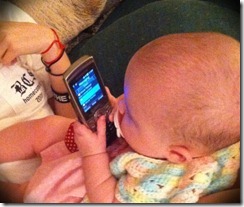(Reposted from Goggle Blogger)

We are in danger of becoming increasingly irrelevant and non-competitive. If we do, we will lose students.
Historically, our competition has come from free public schools, charter schools, and homeschooling. Our new competition is coming from technology enabled courses offered by public schools, colleges and universities, and virtual schools, including virtual Christian schools. This development is changing the educational landscape and the school market. The current recession is likely to accelerate this change.
Public schools are adopting interactive technology and distance learning (D.L.) at an accelerating pace. Moreover, there is an increasing number of online virtual schools in higher education and in K-12 education. These options make virtually (pun intended) any course available to any student anytime, anywhere. Students and their parents are no longer restricted to brick and mortar traditional schools to have access to high quality fully accredited courses.
The Explosion in Distance Learning
Alabama, not historically known for innovation or high quality education, is leading the nation in connecting every public school in the state to online asynchronous courses and synchronous courses offered through video conferencing and other interactive technologies. Every student in the state now has access to a wide range of courses, including honors and AP courses that have historically been only offered to students in larger schools in wealthier school districts. The image below shows some of the courses offered through Alabama's Access Program.


 To view a short news clip from Fox News about the Access program, click here.
To view a short news clip from Fox News about the Access program, click here.
As reflected in the Alabama Access Program, distance learning is exploding. According to Drs. Horn and Christensen (authors of Disrupting Class1) of the Harvard Business School, public education enrollments in online classes have skyrocketed from 45,000 in 2000 to roughly 1 million today. It is projected that by 2020 over 50% of high school classes will be available online1.
The Florida Virtual School (FLVS) reflects this explosion in D.L. Founded in 1997, FLVS currently enrolls 63,675 students in grades 6-12. Enrollment is open to public, private, and home school students.
FLVS offers more than 90 courses—including core subjects, world languages, electives, honors, and over 10 Advanced Placement courses. FLVS courses are accepted for credit and are transferable. Florida Virtual School is accredited by the Southern Association of Colleges and Schools and courses are NCAA approved. FLVS also offers AP Exam reviews in April, even for students who did not take the course through FLVS.

Drs. Horn and Christensen outline four reasons why distance learning will continue to grow:
-
Distance learning technologies will keep improving.
-
Distance learning provides the ability of teachers, students, and parents to select right learning pathways for differentiated learning thus customizing the education to the learning preferences and needs of each child.
-
The looming teacher shortage caused by the retirement of baby boomers will propel schools to move to distance learning to gain access to hard to hire teachers in math, science, and other subjects.
-
The cost of distance learning will fall significantly.
Distance Learning Is and Will Disrupt the Traditional Classroom and School
I highly recommend Disrupting Class: How Disruptive Innovation Will Change the Way the World Learns by Drs. Christensen, Horn, and Johnson. For a good overview, click on the play button below to watch a video podcast interview with the author, which runs approximately four minutes.
The short video below from Harvard Business School provides useful background context to Dr. Christensen's book. A key concept in this video is winning not by doing it better but doing it differently.
The key concepts in the video sound very familiar in our schools.
The Stimulus Plan is to Include $1 Billion for Ed Tech in Public Schools
According to Edweek2, the Obama Administration plans to spend $1 Billion for Ed Tech. The House Democrats' "American Recovery and Reinvestment" plan includes "$1 billion for 21st century classrooms, including computer and science labs and teacher technology training."
The House Democrats' plan overall includes $41 billion to local school districts, including $1 billion made available through the Enhancing Education Through Technology (E2T2) program, which last year was just $263 million. From the House Democrat's proposal:
We will put people to work building 21st century classrooms, labs, and libraries to help our kids compete with any worker in the world.
Such developments have the potential to make public schools more competitive with Christian schools.
Competition from an Unexpected Source-Virtual Christian Schools
I can already hear the rejoinder "but we provide a Christian education in a Christian environment. This type of education cannot be replicated by technology."

It is true that neither distance learning nor any other technology can perfectly replicate the experience of community that one finds in a brick and mortar school. Warm human interactions, prayer in the classroom, chapel services, the excitement and lessons learned through athletics  and fine arts are life changing and life enriching experiences that can only occur through face-to-face human interaction.
and fine arts are life changing and life enriching experiences that can only occur through face-to-face human interaction.
However, it is naive to assume that these rapidly developing technologies do not pose real challenges to our schools--and real opportunities.
The Challenges
1. The number of parents theologically and philosophically committed to Christian education is relatively small. Given the growing shallowness of Christianity in the U.S. and the evangelical church in particular, this number is likely to grow smaller.
As I noted in a previous post, for many parents, the "Christian" in education is not as important as "quality" in education. Many of our parents enroll their children in our schools for reasons other than the development of a biblical worldview, which frankly, most of our parents do not understand because their entire educational experience was secular, not Christian. They may have a Christian heart but most have a secular mind.
Once having experienced the benefits of Christian education, some of our parents come to a deeper understanding of and commitment to the philosophy of Christian education. Most, however, do not start with this understanding and many never acquire it.
Based on formal and informal surveys that I have conducted with parents over the years, I find that parents enroll their children in our schools for the reasons outlined below. Although survey results vary, in general the order provided below reflects the priorities of parents when deciding to enroll their children in a Christian school.
- A sense of security and safety
- Christian atmosphere (meaning good values, nurture, and protection from the "world")
- Academic quality
- Relatively small sizes
- Christian worldview
The essential question for us is "can distance learning replicate the above benefits of Christian education?" I believe that it can--at least partially and most importantly--well-enough for many of our parents. I believe this will become increasingly true for several reasons:
-
Younger parents will be much more knowledgeable and comfortable with online learning (many will experience it first hand in college). Online learning will not have the stigma that it does for many of our current parents, administrators, and teachers.
-
The notion of community is changing due to social networking sites like Facebook.
-
Rising tuition may make Christian education increasingly unattainable for many.
-
Technology will continue to improve resulting in enhanced synchronous interaction through high speed embedded video-conferencing technologies like Wimba.
Moreover, it is interesting to reflect upon how many of the reasons cited by parents for enrolling their children in a Christian school can be at least partially met through online classes.
- Security and safety is provided when students are at home with parents taking coursework online.
- Christian students interacting live with a Christian teacher does provide a Christian atmosphere, albeit in a more limited fashion. Moreover, our students view social interactions differently than we typically do. For them, interaction through social networks and other technologies IS social interaction and quite natural. As evidence, all you have to do is watch a group of teenagers together. They spend as much time texting their friends as they do interacting with those directly in front of them.
- Academic quality can be maintained when highly qualified teachers are teaching using interactive asynchronous and synchronous technology such as video-conferencing, chat rooms, Skype and similar programs. In fact, sometimes the quality can be better! It is now possible and relatively inexpensive for students to take online courses from instructors with Masters and Ph.D.'s, e.g., from India. For an example, click here.
To put this into perspective, consider the following information provided by one online provider of tutoring services.


- The small class size speaks for itself.
- A Christian worldview can be taught by using Christian teachers and Christian material. Sitting in a traditional classroom is not necessarily required. For example, Reformed Theological Seminary offers theological degrees through distance learning. As I was researching material for this article I discovered a video that I did not know existed by my own pastor outlining the benefits of distance learning for theological training.
To the extent that parents believe that they can provide their children most of what is available in a traditional Christian school by combining distance learning, homeschooling, and extra-curricular programs through community programs, we run the risk of experiencing enrollment declines. As technology improves, our younger more technology savvy parents may choose options other than the local Christian school. They will make a cost benefit assessment something like this: "I am willing to get 80% of the benefits of a traditional Christian school for 50% of the cost." The graphic below, which I developed for a workshop I recently conducted, illustrates the calculation being made by parents.

This leads to the next development in the market--the Virtual Christian School.
2. There are a growing number of Christian Virtual Schools such as Sevenstar Christian Academy. Schools such as Sevenstar offer online classes taught by Christian teachers, primarily to students of Christian parents. This is a new development that adds another player in the Christian school market.
As an experiment, I did a simple Google search for "Christian school distance learning". Here is what came up (note there are more than 10 pages of search results):

3. The recession is creating significant challenges for our parents. These challenges may affect parents' decisions regarding the enrollment of their children in a Christian school.
- Many of our families will experience job losses for one or both spouses.
- Many families will receive little or no pay increases, some will experience reductions. On the other hand, most of our schools will raise tuition.
- Employers are shifting health insurance premiums to employees and increasing co-pays thus reducing family disposable income.
- Families have lost wealth making paying for college more difficult or impossible. Some parents will decide to forego paying K-12 tuition to save money for college.
- Families are worried about retirement. Some may reallocate tuition to retirement accounts.
- Grandparents may have less disposable income to assist with tuition.
- Many families will focus on reducing debt and saving money.
4. The availability of high quality academic courses through both Christian and public schools, along with the recession, may encourage more parents to homeschool their children.
The Opportunities
 Although the explosion in distance learning poses challenges, it also presents a significant opportunity. Consider the potential benefits of D.L. for our schools:
Although the explosion in distance learning poses challenges, it also presents a significant opportunity. Consider the potential benefits of D.L. for our schools:
- Distance learning provides a vehicle for extending our school ministries by enabling our schools to offer Christian education to students who do not have access to quality Christian schools or whose parents cannot afford it. Distance learning provides the opportunity to expand the Christian school market in ways hitherto not possible.
- We have the opportunity to form strategic alliances to offer courses to our students that we otherwise could not afford to offer as individuals schools, e.g., Chinese, astronomy, etc.
- A new revenue stream is created by enrolling new students but without the added cost of new facilities and auxiliary services.
- Extending our educational ministry impact to international students along with the opportunity to connect our classrooms with classrooms in other countries thus fostering cross-cultural understanding and deepening our students' interest in world affairs and missions.
These are just a few of the potential benefits of this revolution in technology and learning. The question is "how are we going to respond?" As I see it we have three options:
1. The proverbial ostrich  approach--deny the reality of what is already occurring. Adopting a smug, but in my humble opinion misplaced, confidence that D.L. is a fad or at most a niche phenomenon that will not materially affect the educational marketplace or our schools.
approach--deny the reality of what is already occurring. Adopting a smug, but in my humble opinion misplaced, confidence that D.L. is a fad or at most a niche phenomenon that will not materially affect the educational marketplace or our schools.
2. Adopt a theological superiority complex that in effect relegates distance learning to a sub-Christian status because it lacks the traditional definition of community. I call this the "Christian Luddite Syndrome" or CLS.
3. Prayerfully and creativity determine how we can redeem this new technology for God's glory, the advancement of His kingdom, and for the benefit of our schools and students. In short, we  don't have to throw out the baby with the bath water. Whatever the shortcoming of D.L., we can and should work to redeem the technology to make it all that it can be in service to the mission of Christian education.
don't have to throw out the baby with the bath water. Whatever the shortcoming of D.L., we can and should work to redeem the technology to make it all that it can be in service to the mission of Christian education.
Can we keep up with our competition and should we care? I believe the answer to both questions is an emphatic YES. We face both a challenge and an opportunity. Our response will determine which it will be for our schools.
An African Proverb provides an insightful summary of where we may find ourselves as Christian schools:
Every morning in Africa, a gazelle wakes up.
It knows it must run faster than the fastest lion or it will be killed.
Every morning a lion wakes up.
It knows it must outrun the slowest gazelle or it will starve to death.
It doesn’t matter whether you are a lion or a gazelle.
When the sun comes up, you better start running.
You Are Invited
I am currently working on a major distance learning initiative that will involved several Christian schools in the U.S. and overseas. If you would like to learn more about this initiative and your possible involvement, please email me (christianschooljournalblog@gmail.com) for more information.
References
1. Christensen, C., Horn, M., and Johnson, C., Disrupting class (2008): How disruptive innovations will change the way the world learns, McGrawHill, p. 91
2. Source: http://blogs.edweek.org/edweek/DigitalEducation/2009/01/1_billion_for_ed_tech_in_house.html
Technorati Tags: Distance Learning,market,Christian school,Christian education,Technology,Ed Tech,Educational technology,innovation,disruptive technology,disrupting class,educational reform,enrollment














 Funding Cuts Compel Florida Virtual School to Get By With Less
Funding Cuts Compel Florida Virtual School to Get By With Less  Nevertheless, I also share the conviction that technology, like many good things in our lives, can become an obsession and a cruel master. Any addiction, even to good things, is harmful and unbiblical whether it is sex, food, work, or technology.
Nevertheless, I also share the conviction that technology, like many good things in our lives, can become an obsession and a cruel master. Any addiction, even to good things, is harmful and unbiblical whether it is sex, food, work, or technology.![[SLOWSIDE4]](http://s.wsj.net/public/resources/images/PT-AM329_SLOWSI_D_20090821171915.jpg) ability to know our world, encouraging a further distancing from our bodies and our natures and our communities. We can change this; we have to change it. Of course email is good for many things; that has never been in dispute. But we need to learn to use it far more sparingly, with far less dependency, if we are to gain control of our lives.
ability to know our world, encouraging a further distancing from our bodies and our natures and our communities. We can change this; we have to change it. Of course email is good for many things; that has never been in dispute. But we need to learn to use it far more sparingly, with far less dependency, if we are to gain control of our lives. 
 automobile whose speedometer dial includes the number 160 can travel “up to 160 MPH.” When shopping for a car or an ISP, claims shouldn’t be taken as facts — though some are safer to verify than others.
automobile whose speedometer dial includes the number 160 can travel “up to 160 MPH.” When shopping for a car or an ISP, claims shouldn’t be taken as facts — though some are safer to verify than others.



 To view a short news clip from Fox News about the Access program, click
To view a short news clip from Fox News about the Access program, click 

 and fine arts are life changing and life enriching experiences that can only occur through face-to-face human interaction.
and fine arts are life changing and life enriching experiences that can only occur through face-to-face human interaction.



 Although the explosion in distance learning poses challenges, it also presents a significant opportunity. Consider the potential benefits of D.L. for our schools:
Although the explosion in distance learning poses challenges, it also presents a significant opportunity. Consider the potential benefits of D.L. for our schools: approach--deny the reality of what is already occurring. Adopting a smug, but in my humble opinion misplaced, confidence that D.L. is a fad or at most a niche phenomenon that will not materially affect the educational marketplace or our schools.
approach--deny the reality of what is already occurring. Adopting a smug, but in my humble opinion misplaced, confidence that D.L. is a fad or at most a niche phenomenon that will not materially affect the educational marketplace or our schools. don't have to throw out the baby with the bath water. Whatever the shortcoming of D.L., we can and should work to redeem the technology to make it all that it can be in service to the mission of Christian education.
don't have to throw out the baby with the bath water. Whatever the shortcoming of D.L., we can and should work to redeem the technology to make it all that it can be in service to the mission of Christian education. Dr. Barrett Mosbacker, PublisherI have a confession to make—I can be a workaholic. I’m not as bad as depicted in this picture but I have caught myself checking emails on my iPhone in less than appropriate places!
Dr. Barrett Mosbacker, PublisherI have a confession to make—I can be a workaholic. I’m not as bad as depicted in this picture but I have caught myself checking emails on my iPhone in less than appropriate places! For example, in the past I would have missed the simple elegance of the wine bottles and glasses sitting outside a store in Birmingham. I would have walked by with hardly a glance. Instead, I stopped and took a picture. I was surprised by how nice a picture such a simple sidewalk display could make.
For example, in the past I would have missed the simple elegance of the wine bottles and glasses sitting outside a store in Birmingham. I would have walked by with hardly a glance. Instead, I stopped and took a picture. I was surprised by how nice a picture such a simple sidewalk display could make.






